 Nimbos, the Dr and I braved the grey drizzle yesterday for a nose round Battersea Power Station – which is open to the public at the moment while Real Estate Opportunities and Treasury Holdings UK attempt to get backing for a major transformation of the site.
Nimbos, the Dr and I braved the grey drizzle yesterday for a nose round Battersea Power Station – which is open to the public at the moment while Real Estate Opportunities and Treasury Holdings UK attempt to get backing for a major transformation of the site.I love a nose round buildings like this. My freelance efforts have got me into various bars and back corridors of the Palace of Westminster and other government buildings. I've been on the top floor of 1 Canada Square in Canary Wharf and on the roof and in the basement of posh Eltham Palace. And then there's all the poking about behind closed doors that's part of Open House. It's something the Dr's got me into – her chief delight is in getting into bits of museums and historical sites not normally open to the public.
Battersea is one of the icons of the London skyline. It's the cover to Pink Floyd's album Animals and the factory churning out Cybermen in recent Doctor Who. (It also appeared in 1964's Dalek Invasion of Earth, with a nuclear power facility grafted on.)
I pass the power station on the train into town. And I got pretty close to it during my corporate parasite days when a client took me to see Cirque du Soleil who'd erected their tent just in front of it. But yesterday's day trip was something else.
The Grade 2* listed building covers a bit more than six acres – one of the largest brick buildings in Europe. The hand-out says that:
The ginormous, functional edifice is full of lovely features. The brickwork include art deco pleats and fiddly bits. Turbine Hall A – the first of two stops on the tour – is still panelled with Italian marble, like some vast tiled bathroom. The tiles have a practical purpose in being easy to keep clean, but they also have a sparkling, palatial effect. Apparently, “despite the war-time shortage, stainless steel was used for Battersea B Auxilary Control Room”.“construction of the steel frame commenced in 1929 with Battersea A completed in 1935 and Battersea B, despite the war, coming into service in 1944 with the fourth chimney completed in 1955 ... Sir Giles Gilbert Scott, architect of Bankside power station (Tate Modern) and the red telephone box was appointed architect of Battersea Power Station in 1930.”
At it's height, Battersea generated 509 megawatts – a fifth of London's power and about half the output of a modern nuclear power plant. The excess heat was ducted out to heat 11,000 homes in Pimlico across the river. Battersea A ran for 42 years, ceasing generation in 1975. Battersea B wound up its efforts in 1983.
And since then... nothing. There have been plots and plans for years, but the place has been left to moulder and decay. One owner in the intervening years criminally took the roof off the central Boiler House as the start of renovation works that never followed on, and the weather and elements got in.
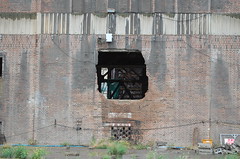 Yesterday's drizzle and misery matched the sorry state of the once mighty powerhouse. It's a whacking great metaphor in red brick and steel, a temple to the dead king Ozymandias. The great windows are broken, there are huge gouges in the walls. It's like peeking round a ruined cathedral, the dissolution only just done.
Yesterday's drizzle and misery matched the sorry state of the once mighty powerhouse. It's a whacking great metaphor in red brick and steel, a temple to the dead king Ozymandias. The great windows are broken, there are huge gouges in the walls. It's like peeking round a ruined cathedral, the dissolution only just done.At convenient stopping places on the route stood CGI suggestions of how the view might be transformed. There are shops and cafes, offices and homes, an extension to the Northern line and routes for bikes and walkers. In the empty space south of the station itself they hope to construct a vast and green eco-dome, underneath an enormous chimney that – they say – generates all the power for the complex naturally and cleanly.
The design has a Ken Adam feel about it. Or perhaps that's just my response to any grand design effort with curves and circles in it, that is BIG and MAD and COOL. It's an extraordinary, boggling prospect. But then any use of this kind of huge space and iconic site has to be a bit loopy to justify bothering in the first place. And it's far more exciting than just luxury flats and offices, which has been the lot of several other bold architectural efforts in the capital.
I wondered if this strange, impossible-seeming prospect was how it must have seemed to people after the Great Fire in 1666. That had seen the final end of an old church across the river, one used for years as a stable. And there would be young Chris Wren ranting on to anyone who'd listen: “And then on top of that there'll be this fuck-off dome!”
Nimbos pointed out Wren would have gunpowdered any last remnant of the old building before starting work on his replacement. The wheeze of the thinking here is to support and build upon the physical and metaphysical pre-existing structure.
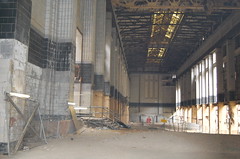 We followed the path to the first viewpoint, a view into Turbine Hall A. Security guards stood dolefully in the rain or what passed for shelter, all smiles and welcome despite the gloom. One explained she had only just finished a four-day stint under heavy sunshine at some music festival in Cambridge. Now she got to shiver all day in a chilly wind tunnel, the sight of visitors glooping through the rain and gravel in their flip-flops only making her feel more cold.
We followed the path to the first viewpoint, a view into Turbine Hall A. Security guards stood dolefully in the rain or what passed for shelter, all smiles and welcome despite the gloom. One explained she had only just finished a four-day stint under heavy sunshine at some music festival in Cambridge. Now she got to shiver all day in a chilly wind tunnel, the sight of visitors glooping through the rain and gravel in their flip-flops only making her feel more cold.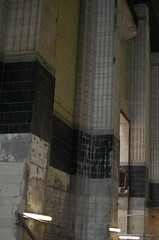 We marvelled at the huge space and potential, and then the sumptuous if dirt-smudged Italian marble still dazzling the vast walls. We took turns to poke lenses through the wire fence, trying to snap all the details for our various architect chums.
We marvelled at the huge space and potential, and then the sumptuous if dirt-smudged Italian marble still dazzling the vast walls. We took turns to poke lenses through the wire fence, trying to snap all the details for our various architect chums.Then, back out into the rain and gale, venturing round the building to what they hope will one day be a riverside walk. The wire fence kept us away from the gravelly spoil heaps – with warnings of rats and monsters – and we took shelter behind three porter loos to grab another bunch of snaps.
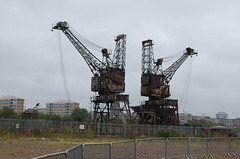 I asked the Dr to snap the north side of the Thames, to show how different the trees and blocks of flats are to the same spot in an alternative universe where Doctor Who and his friends dared to stop the Cybermen. Not sure you can really see this pedantic point in the drizzly pictures.
I asked the Dr to snap the north side of the Thames, to show how different the trees and blocks of flats are to the same spot in an alternative universe where Doctor Who and his friends dared to stop the Cybermen. Not sure you can really see this pedantic point in the drizzly pictures. Then we poked our noses into the Boiler House, a vast space now open to the air. Again there were telling fragments of its former majesty – the vivid pale blue of what once had been stairwells, struts and supports that had once been different levels.
Then we poked our noses into the Boiler House, a vast space now open to the air. Again there were telling fragments of its former majesty – the vivid pale blue of what once had been stairwells, struts and supports that had once been different levels.If the team get planning permission next year, it'll then be another decade before the thing's completed. It's a bold, exciting project, a fine two fingers flicking at the threat of economic hardship. Perhaps it's an all-mighty long shot. But Battersea (and Pink Floyd) long ago showed us that pigs can fly.
Thence to Liadnan and Pashazade's engagement soiree, where I met many new and lovely people, bored them too much about things Droo, and drank rather too much beer. Hooray!
ETA: Churchill Gardens, the estate on the river opposite Battersea, featured in Britain From Above last night.
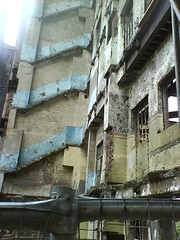
It reminds me of "Inferno" for some reason.
ReplyDelete